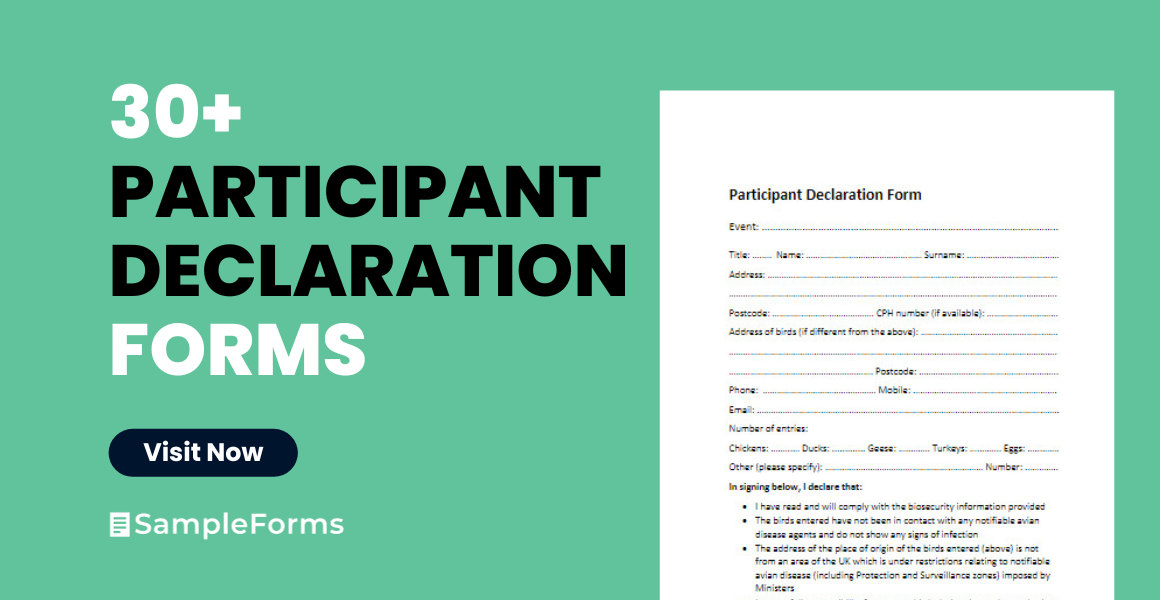A Participant Declaration Form is a vital document used across various domains, from healthcare and sports to legal matters and research. This comprehensive guide explores the meaning and significance of these forms, delves into different types and real-world examples, and provides valuable insights on how to create effective forms. With practical tips and expert advice, you’ll gain a deep understanding of Participant Declaration Forms and their role in ensuring clarity, compliance, and informed participation.
What is a Participant Declaration Form? – Definition
A Participant Declaration Form, in essence, is a formal document that serves as a written acknowledgment and agreement between an individual and an organization or entity. It outlines specific terms, conditions, or expectations related to the individual’s participation in an activity, event, research study, or program. This legally binding contract form typically addresses matters like consent, liability, confidentiality, and compliance with rules or regulations. Its primary purpose is to ensure clarity, transparency, and mutual understanding between participants and the involved parties.
What is the Meaning of the Participant Declaration Form?
The meaning of a Participant Declaration Form lies in its role as a written agreement form that defines the terms and conditions governing an individual’s participation in a particular activity or program. This document holds significance as it clarifies the rights, responsibilities, and expectations of both the participant and the organizing entity. It addresses various aspects, such as consent, confidentiality, liability, and compliance with rules, ensuring that all parties involved share a common understanding of their roles and obligations throughout the engagement.
What is the Best Sample Participant Declaration Form?
Creating the best sample Participant Declaration Form involves tailoring it to the specific needs and legal requirements of the activity or program it serves. Below is a detailed breakdown of the essential components and considerations for such a form:
1. Title and Introduction:
- A clear and descriptive title that reflects the purpose of the form, such as “Participant Declaration and Consent Form.”
- An introductory paragraph explaining the context, significance, and objectives of the form.
2. Participant Information:
- Fields for the participant’s complete and accurate personal information, including:
- Full name
- Address
- Contact number(s)
- Email address
- Date of birth
- Any relevant identification numbers (e.g., student ID, membership ID)
3. Activity or Program Details:
- A section specifying the following details related to the activity, event, or program:
- Name of the activity or program
- Date(s) and time(s)
- Location or venue
- Nature and purpose of the activity
4. Consent and Acknowledgment:
- A clear statement where the participant explicitly provides informed consent to participate in the specified activity.
- An acknowledgment section where the participant confirms understanding of:
- Risks associated with the activity
- Responsibilities and expectations
- Agreement to abide by rules and guidelines
5. Confidentiality and Privacy:
- A paragraph outlining how personal and sensitive data collected during the activity will be managed, ensuring confidentiality and compliance with relevant data protection laws.
6. Liability and Release:
- A section detailing the allocation of liability, including:
- Any waivers or limitations of responsibility on the part of the organizing entity
- A release clause in which the participant agrees not to hold the entity accountable for injuries, losses, or damages incurred during the activity.
7. Code of Conduct and Rules:
- A section that clearly outlines:
- The expected code of conduct for participants
- Specific rules and regulations applicable to the activity
- Consequences for non-compliance or misconduct
8. Emergency Contact Information:
- Fields for emergency contact information, including the name, relationship, and phone number of a designated contact person in case of emergencies.
9. Signature and Date:
- A designated space for the participant’s signature, affirming their consent and acknowledgment of the terms.
- A date field for the participant to indicate the date of signing.
10. Witness or Notary (if required):
- If mandated by legal requirements, a section for a witness to attest to the participant’s signature or a notary public to notarize the form.
11. Terms and Conditions:
- A paragraph where participants confirm that they have read, fully understood, and voluntarily agreed to the terms and conditions specified in the form.
12. Review and Contact Information:
- Encouragement for participants to thoroughly review the form and seek clarification on any concerns before signing. Contact information (phone number and email address) for participants to reach out for inquiries or further information.
13. File Retention:
- Information on how long the organization will retain the signed forms and a statement regarding the secure disposal of the forms once they are no longer needed.
14. Governing Law:
- A clause specifying the governing law or jurisdiction that will apply in case of any legal disputes or conflicts.
Creating the best sample Participant Declaration Form involves careful consideration of the specific context, potential risks, and legal requirements associated with the activity or program. Legal consultation and compliance with relevant regulations are crucial to ensure the form’s validity and effectiveness in protecting the rights and responsibilities of both participants and organizers. You should also take a look at our Employee Declaration Form.
FREE 30+ Participant Declaration Forms in PDF
1. Participant Declaration Form
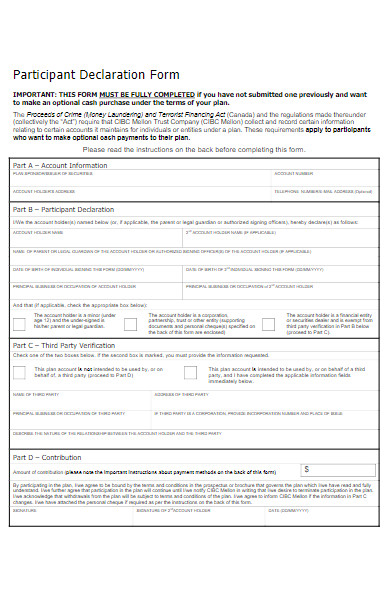
2. Reinvestment Enrollment Participant Declaration Form
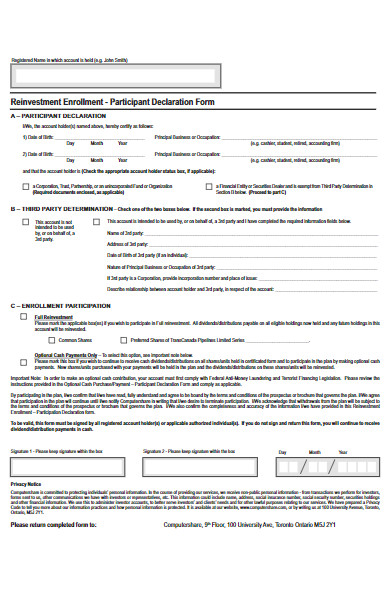
3. Sample Participant Declaration Form

4. Event Participant Declaration Form

5. Participants Declaration to Prevent Plagiarism Form
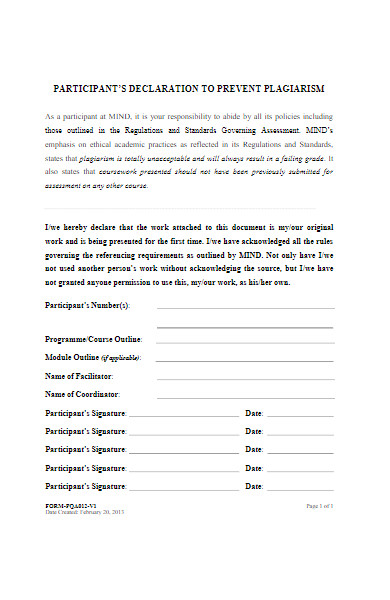
6. Participant Declaration Information Form

7. Study Program Participant Declaration Form
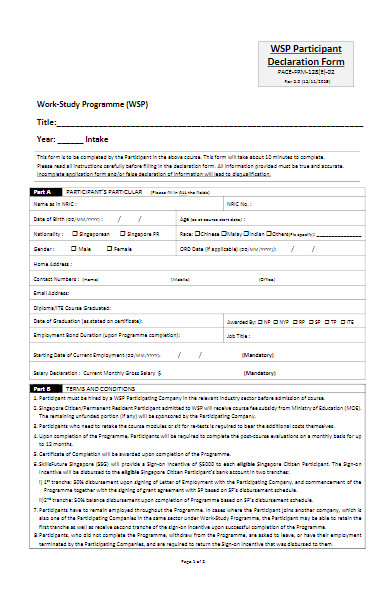
8. Club Event Participant Declaration Form
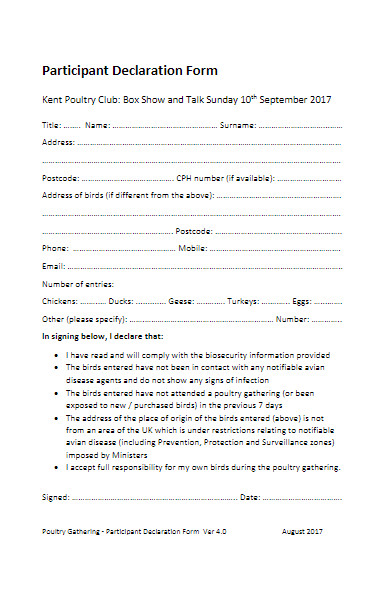
9. Participant Declaration Form for Event
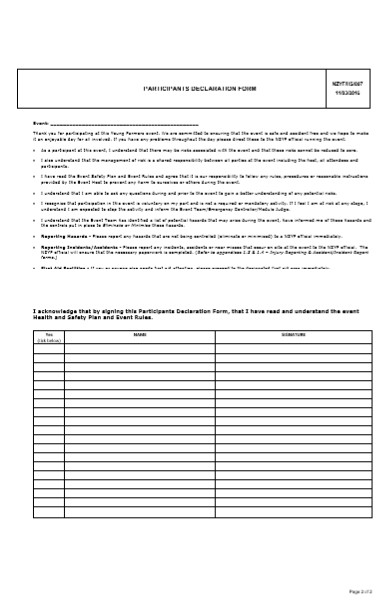
10. Project Participant Declaration Form
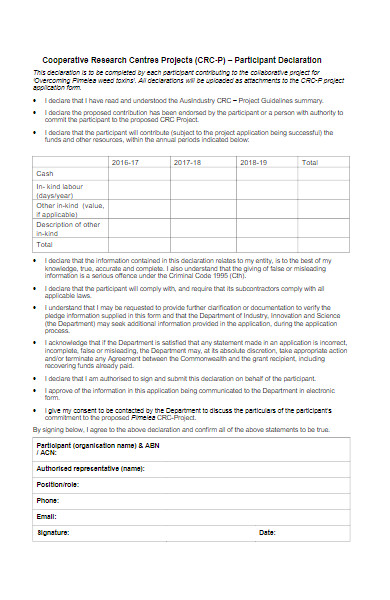
11. Free Participant Declaration Form for Event
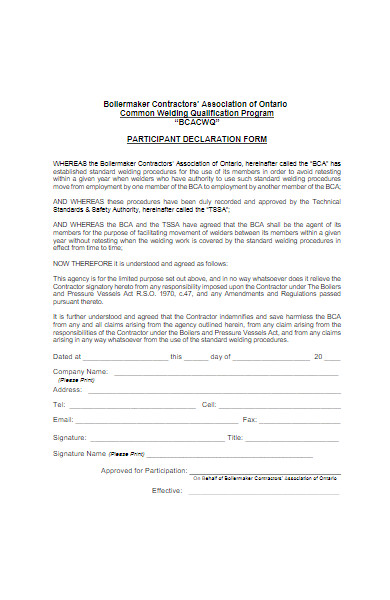
12. Enrollment Participant Declaration Form
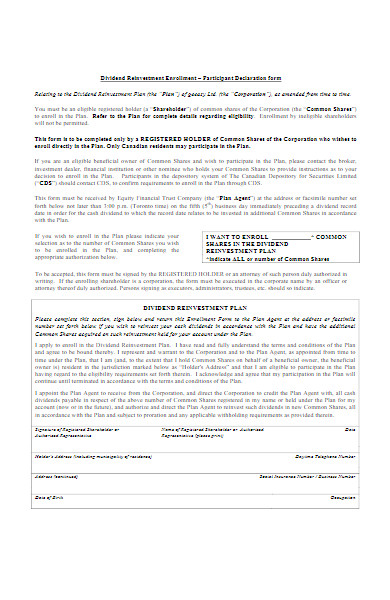
13. Simple Participant’s Declaration Form

14. Declaration of Participant Registration Form
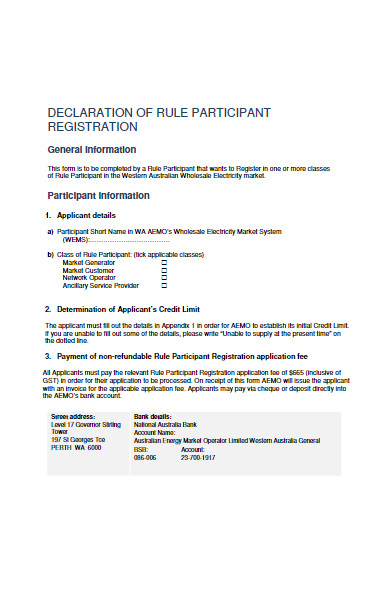
15. Participant Declaration and Indemnity Form
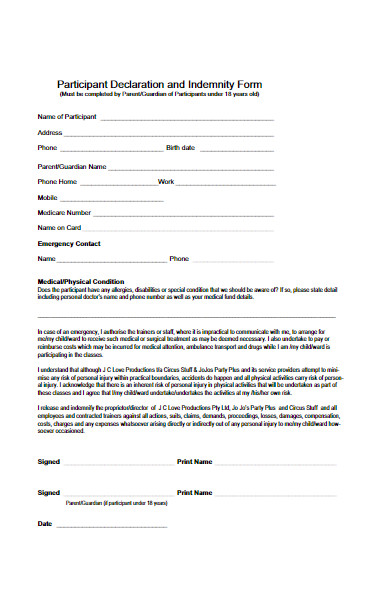
16. Health Declaration Form for Participants
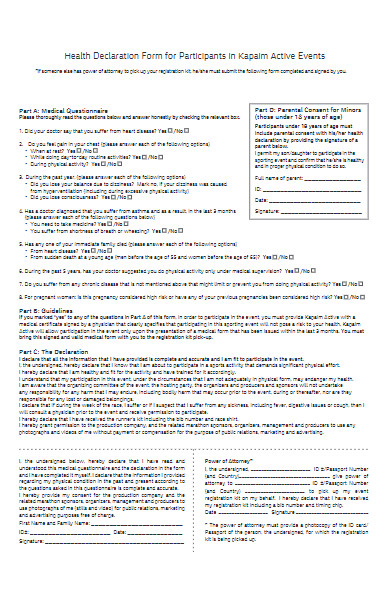
17.Participant Citizenship Declaration Form
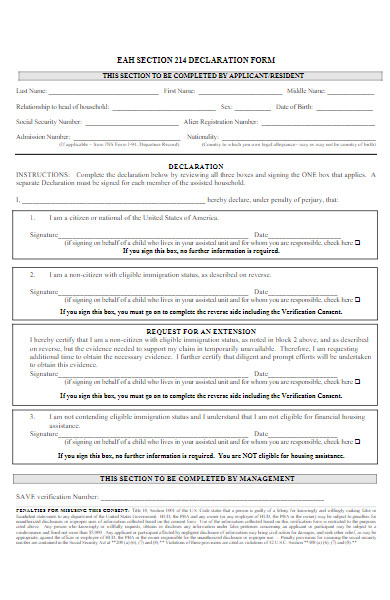
18. Research Center Project Participant Declaration Form
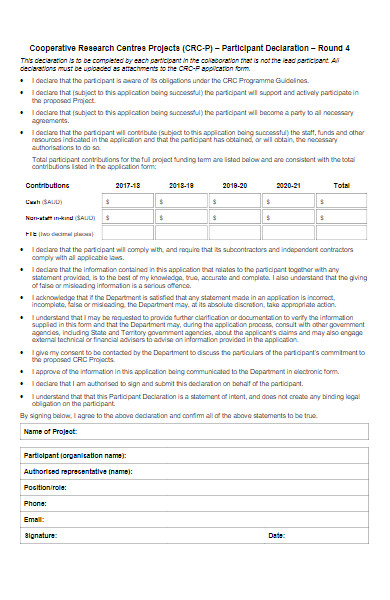
19. Participant Declaration and Release Form
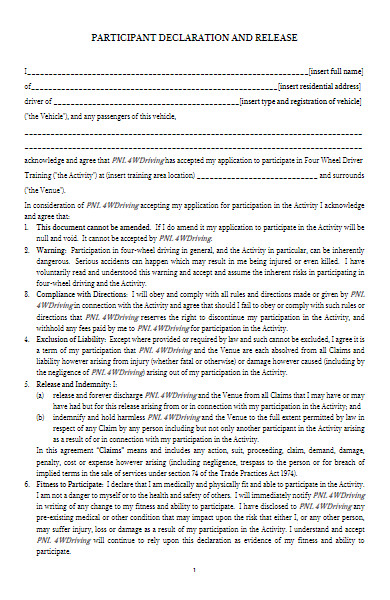
20. Basic Participant Declaration Form
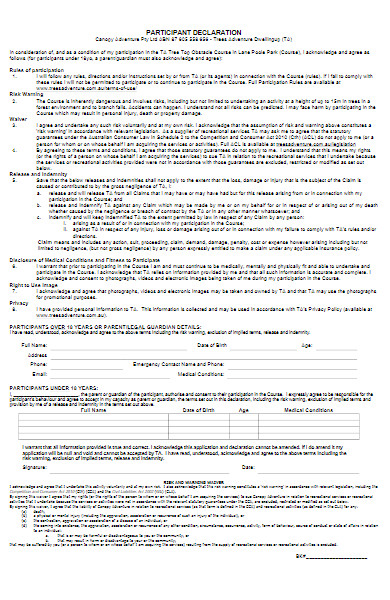
21. Group Member Participant Declaration Form

22. Participant IT Declaration Form
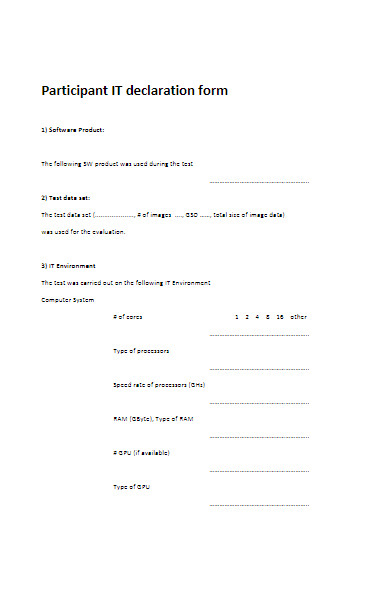
23. Staff Participant Declaration Form
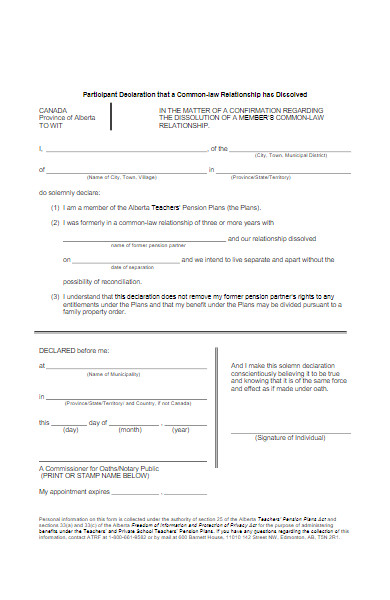
24. Liability Declaration Form for Participant
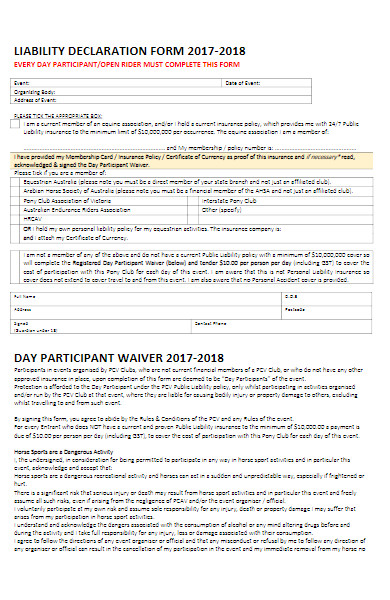
25. Gathering Participant Declaration Form
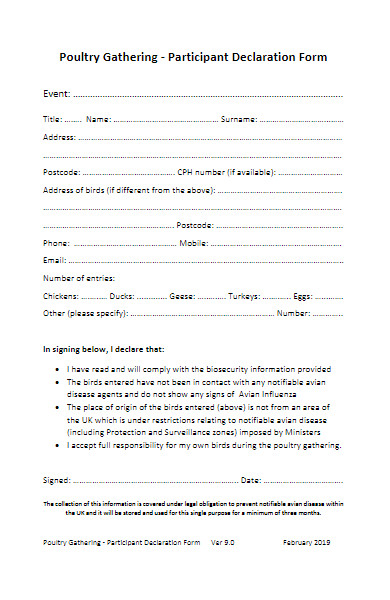
26. Participant Declaration Form in PDF
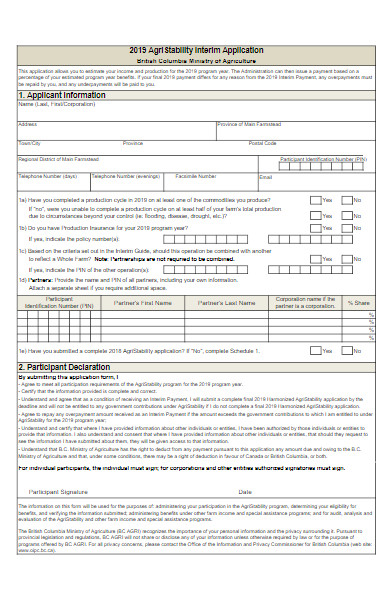
27. Student Non-Participant Declaration Form
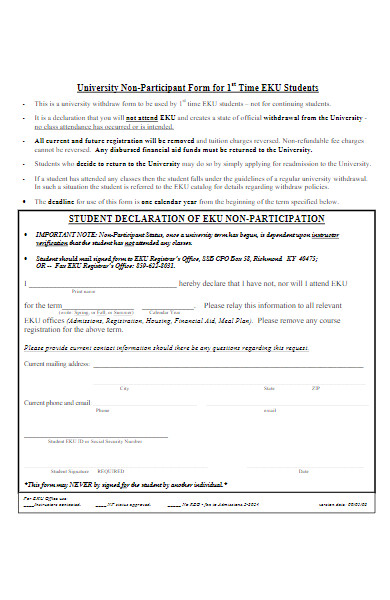
28. Participant Declaration Form Example
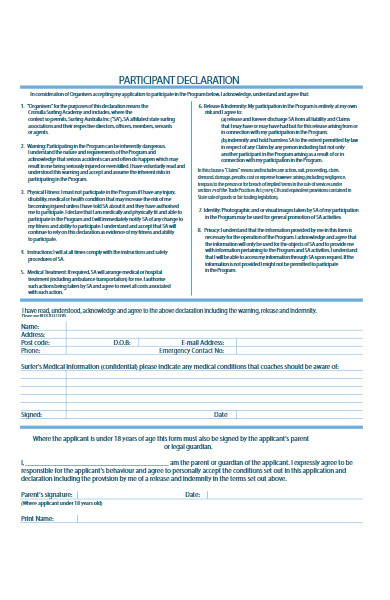
29. Participant Eligibility Declaration Form
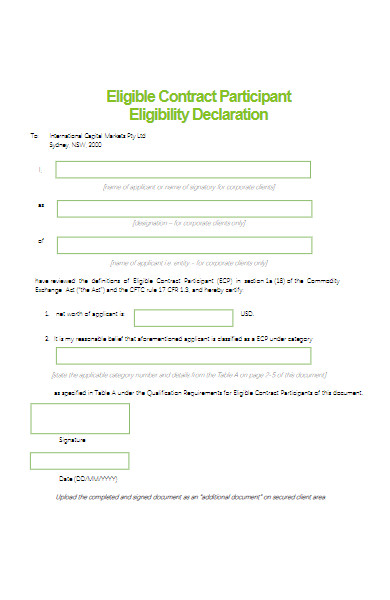
30. Participant Declaration and Disclaimer Form

31. Standard Participant Declaration Form

Why do I need to fill out a Participant Declaration Form?
Filling out a Participant Declaration Form serves several important purposes:
- Informed Consent: It ensures that participants are fully aware of the nature of the activity or program they are joining. By reading and signing the form, participants acknowledge their understanding of the associated risks, responsibilities, and rules.
- Liability and Protection: The form may allocate responsibilities and liabilities, clarifying the roles of both participants and organizers. This helps protect all parties in case of accidents or disputes.
- Legal Compliance: In some cases, such as research studies or certain events, organizations are legally required to obtain written consent from participants. The form ensures compliance with these legal obligations.
- Documentation: The signed form serves as a record of the participant’s agreement to the terms and conditions. It can be used as evidence in case of any legal disputes or claims.
- Clarity and Transparency: The form promotes transparency by clearly outlining the rules and expectations for participants. It reduces misunderstandings and ensures that everyone is on the same page.
In essence, filling out a Participant Declaration Form is a means of safeguarding both participants and organizers, ensuring that everyone involved has a clear understanding of their roles and responsibilities. It enhances the overall safety, accountability, and integrity of the activity or program.
Can I refuse to sign a Participant Declaration Form?
Yes, generally, you have the right to refuse to sign a Participant Declaration Form. Participation in any activity or program should be voluntary, and you cannot be forced to sign such a form against your will.
However, it’s essential to understand the implications of not signing the form:
- Non-Participation: If you refuse to sign, you may be excluded from participating in the activity or program. Some organizations or events may have a policy that requires all participants to sign the form as a condition of entry.
- Limited Rights: By not signing, you may waive certain rights and protections outlined in the form. This could affect how disputes or issues are resolved in case of accidents or disagreements.
- Informed Decision: Before refusing to sign, carefully review the form’s contents to ensure you understand what you might be foregoing by not participating.
If you have concerns or questions about the printable form‘s terms or if you believe any of the terms are unreasonable, it’s advisable to discuss these concerns with the organizers. They may be willing to address your specific questions or modify the form if appropriate. Ultimately, the decision to sign or not sign should be made based on your comfort level with the terms and your desire to participate in the given activity or program.
Are there any legal implications to signing a Participant Declaration Form?
Yes, signing a Participant Declaration Form can have legal implications, and it’s important to be aware of them. The specific legal implications can vary based on the content and language of the fillable form, as well as the governing laws in your jurisdiction. Here are some common legal implications:
- Informed Consent: By signing the form, you are providing informed consent to participate in the activity or program. This means you understand the associated risks and responsibilities, and you agree to abide by the rules and guidelines outlined in the form.
- Liability: The form may allocate responsibilities and liabilities between participants and the organizing entity. Signing the form could affect your ability to hold the organization accountable for injuries or losses incurred during the activity.
- Legal Agreement: In some cases, the Participant Declaration Form may be considered a legally binding contract. This means that both you and the organizing entity are bound by the terms and conditions stated in the form.
- Evidence: The signed form serves as evidence of your agreement to the terms. In case of disputes or legal actions, the form can be used as proof of your consent and understanding.
- Legal Compliance: Some activities or programs are subject to specific legal regulations, and signing the form ensures compliance with these laws. Failure to comply with legal requirements could lead to legal consequences.
- Enforceability: Courts may consider the enforceability of the form, especially if it contains terms that are considered unreasonable or against public policy. Courts may uphold or invalidate certain provisions based on legal standards.
- Dispute Resolution: The form may specify how disputes will be resolved, whether through arbitration, mediation, or legal action. Your signature indicates your agreement to the chosen dispute resolution process.
Given these legal implications, it’s crucial to carefully read and understand the content of a Participant Declaration Form before signing it. If you have any concerns or questions about the form’s terms, you may consider seeking legal advice or discussing your concerns with the organizing entity to ensure that you make an informed decision regarding participation. Our Patient Declaration Form is also worth a look at
Are there any additional forms or documents I need to complete alongside the Participant Declaration Form?
The requirement for additional forms or documents alongside the Participant Declaration Form can vary depending on the nature of the activity or program and the policies of the organizing entity. Here are some common additional forms or documents that participants may be asked to complete:
- Medical Waiver or Health Assessment: For certain physical activities or programs, participants may need to provide a medical waiver or complete a health assessment form to ensure they are physically capable of participating safely.
- Emergency Contact Information: Participants may be required to provide emergency contact details separate from the Participant Declaration Form to ensure quick communication in case of emergencies.
- Photo Release: If the activity involves photography or video recording, participants might need to sign a separate photo release form granting permission for their images to be used for promotional or documentation purposes.
- Parental Consent Form: In the case of minors participating, parents or guardians may need to sign a parental consent form in addition to the Participant Declaration Form, granting permission for their child’s participation.
- Code of Conduct or Behavior Agreement: Some activities or programs may require participants to sign a code of conduct or behavior agreement to outline expected behavior and consequences for violations.
- Travel Consent Form: If the activity involves travel, participants, especially minors, may need to complete a travel consent form, authorizing their participation in the trip.
- Payment or Fee Agreement: If there are fees associated with the activity, participants may need to complete a separate payment or fee agreement to confirm their financial obligations.
- Release of Liability for Minors: Parents or guardians of minors might be asked to sign a release of liability form, indicating that they understand the risks involved and absolving the organizing entity of certain responsibilities.
- Specialized Consent Forms: Depending on the nature of the activity (e.g., medical research, experimental studies), participants may be required to complete specialized consent forms tailored to the specific risks and requirements.
- Background Check Authorization: For activities involving vulnerable populations, such as children or the elderly, participants may be asked to authorize background checks as a condition of participation.
It’s essential to carefully review all facility forms and documents provided by the organizing entity to ensure compliance with their policies and requirements. If you have any questions or concerns about additional forms, it’s advisable to seek clarification from the organizers or legal counsel if necessary. This helps ensure a smooth and informed participation process.
What is the purpose of a Participant Declaration Form?
The primary purpose of a Participant Declaration Form is to establish clear and informed consent between participants and the organizing entity of an activity or program. Here are the key purposes:
- Informed Consent: The form ensures that participants are fully aware of the nature of the activity, its associated risks, and the rules and guidelines they must follow. By signing the form, participants acknowledge that they understand what they are getting involved in.
- Liability and Responsibility: The form may allocate responsibilities and liabilities between the participants and the organizing entity. It clarifies the roles and obligations of each party, reducing potential legal disputes.
- Legal Compliance: In some cases, such as medical research studies or certain events, the law may require written consent from participants. The form helps the organizing entity comply with these legal obligations.
- Documentation: A signed Participant Declaration Form serves as a documented record of the participant’s agreement to the terms and conditions. It can be used as evidence in case of disputes or claims.
- Clarity and Transparency: The form promotes transparency by clearly outlining the rules and expectations for participants. It reduces misunderstandings and ensures that everyone is on the same page.
- Risk Mitigation: By signing the form, participants acknowledge the potential risks associated with the activity. This can be crucial for activities with inherent risks, such as adventure sports or clinical trials.
- Code of Conduct: The form may include a code of conduct that participants agree to follow. This helps maintain a safe and respectful environment.
- Privacy and Data Protection: In some cases, the form may address the collection and use of personal information, ensuring compliance with data protection laws and safeguarding participants’ privacy.
In summary, a Participant Declaration Form is a critical tool for establishing mutual understanding, protecting the rights of both participants and organizers, and ensuring that everyone involved in an activity or program is fully informed and consents to their roles and responsibilities.
Do I have to sign a Participant Declaration Form to participate?
In most cases, participation forms in an activity or program may be contingent upon signing a Participant Declaration Form. However, whether you have to sign the form depends on the policies and requirements set by the organizing entity. Here are some key points to consider:
- Organizational Policy: The policies of the organization or entity hosting the activity or program often dictate whether participants are required to sign a Participant Declaration Form. These policies are typically established to ensure clarity, safety, and legal compliance.
- Nature of the Activity: Certain activities, especially those with inherent risks or specific legal requirements, may necessitate the use of such forms to protect both participants and organizers. Examples include adventure sports, medical research studies, or events involving minors.
- Legal Regulations: In some cases, local or national laws may mandate the use of written consent forms for specific activities or events. Failure to comply with these legal requirements can result in legal consequences for the organizing entity.
- Voluntary Participation: While signing the form is often a requirement, participation in the activity is typically voluntary. You cannot be forced to participate against your will. However, if you choose not to sign the form, you may not be allowed to join the activity.
- Informed Decision: Before signing the form or choosing not to sign, it’s essential to carefully read its contents to understand the terms, risks, and responsibilities involved. If you have concerns or questions about the form, you may discuss them with the organizers for clarification.
In summary, while the signing of a Participant Declaration Form is commonly required for participation in many activities, it’s important to consider the specific context, the policies of the organizing entity, and any legal requirements that may apply. If you have doubts or concerns, it’s advisable to seek clarification from the organizers to make an informed decision about your participation. In addition, you should review our Health Declaration Forms.
Is there a minimum age requirement for signing a Participant Declaration Form?
The minimum age requirement for signing a Participant Declaration Form can vary depending on the nature of the activity or program, local regulations, and the policies of the organizing entity. Here are some key points to consider:
- Age Restrictions: Some activities may have specific age restrictions due to safety concerns or legal requirements. For example, certain adventure sports may require participants to be a minimum age to ensure they have the physical and mental capacity to participate safely.
- Parental Consent: In cases where minors (individuals below the age of 18) wish to participate, parental or guardian consent may be required in addition to the minor’s signature on the form. This ensures that a legal guardian is aware of and approves of the minor’s involvement.
- Capacity to Understand: The minimum age for signing a Participant Declaration Form also takes into account an individual’s capacity to understand the form’s terms and implications. In many jurisdictions, minors may not be legally bound by contracts or agreements they sign, so parental consent becomes crucial.
- Legal Requirements: Local laws and regulations may dictate specific age requirements for certain activities. Organizers are typically responsible for ensuring compliance with these legal requirements.
- Organizational Policies: The policies of the organizing entity may set age restrictions based on their risk assessment and safety considerations. These policies aim to protect both participants and the organization itself.
It’s essential to review the specific requirements outlined by the organizing entity for the activity or program you are interested in. If you are a parent or guardian of a minor participant, you should also be aware of any additional consent forms or requirements. If there are age-related questions or concerns, it’s advisable to communicate with the organizers to clarify the rules and eligibility criteria.
How can I contact the organization if I have questions or concerns about the Participant Declaration Form or the activity?
Contacting the organizing organization or entity for questions or concerns about the Participant Declaration Form or the activity is a prudent step. Here’s how you can typically reach out to them:
- Contact Information on the Form: Start by checking the Participant Declaration Form itself. Often, it will include contact information, such as a phone number or email address, for inquiries or concerns.
- Organizer’s Website: If the organizing entity has a website, visit it to find contact details. They may have a dedicated “Contact Us” page with phone numbers, email addresses, or contact forms.
- Event or Program Website: If the activity or program has a dedicated website or event page, look for contact information there. Organizers often provide a way to get in touch for participant inquiries.
- Email: Send an email to the provided email address or use a general contact email if available. Clearly state your questions or concerns and include your contact information for a response.
- Phone: If a phone number is provided, you can call the organizing entity to speak directly with a representative. Be prepared to explain your questions or concerns clearly.
- In-Person: If the activity or program is local, you may visit the organizer’s office or location in person to seek clarification or assistance.
- Social Media: Some organizations maintain social media profiles where you can send messages or post questions. Check if the entity has a presence on platforms like Facebook or Twitter.
- Participant Information Session: If the activity or program hosts information sessions or orientations, attend these events to ask questions in person.
When reaching out, be polite and concise in your communication. Clearly state your concerns or questions about the Participant Declaration Form or the activity and provide any necessary context. Organizers are generally willing to address participant inquiries and provide clarification to ensure a smooth and informed participation experience.
How to Create a Participant Declaration Form?
Creating a Participant Declaration Form involves several steps to ensure that it effectively communicates the terms, expectations, and responsibilities to participants. Here’s a step-by-step guide:
Step 1: Define the Purpose and Scope
- Determine the specific purpose of the form. What activity or program does it relate to, and what information is essential to convey? Define the scope of the form.
Step 2: Identify Legal and Regulatory Requirements
- Research any legal or regulatory requirements related to the activity or program. Ensure that the form complies with these regulations.
Step 3: Draft the Content
- Create a clear and concise document that includes the following elements:
- Title: “Participant Declaration Form”
- Introduction: Explain the purpose of the form and the importance of participant consent.
- Participant Information: Include fields for the participant’s name, contact details, and any relevant identifiers.
- Activity Details: Describe the nature, date, time, and location of the activity or program.
- Risks and Responsibilities: Clearly outline the potential risks associated with the activity and the responsibilities of participants.
- Code of Conduct: Specify expected behavior and any rules participants must follow.
- Liability and Release: Clarify the allocation of responsibilities and liability between participants and the organizing entity.
- Emergency Procedures: Provide information on what to do in case of emergencies.
- Privacy and Data Protection: Explain how participant information will be used and protected, ensuring compliance with privacy laws.
- Signature Section: Include a space for the participant’s signature and the date.
- Witness or Notary Section: If required, provide space for witnesses or notaries to sign and verify the participant’s identity.
Step 4: Review and Legal Consultation
- Have the draft reviewed by legal counsel or experts to ensure its legality, clarity, and compliance with all relevant laws and regulations.
Step 5: Design and Formatting
- Format the form in a clear and organized manner, using readable fonts and appropriate spacing. Ensure that it’s easy to understand.
Step 6: Create a Digital Version
- If the form will be distributed electronically, create a digital version that participants can fill out and sign electronically.
Step 7: Test the Form
- Conduct a test run to ensure that the form functions correctly and is user-friendly, especially for digital versions.
Step 8: Distribution
- Decide how participants will receive the form. It could be distributed via email, through a website portal, or in person at an event.
Step 9: Collect Signed Forms
- Establish a process for collecting signed forms from participants. Ensure that participants have the opportunity to ask questions before signing.
Step 10: Retention and Records
- Safely store and retain the signed forms as legal records for the specified period, as required by applicable laws and regulations.
Step 11: Provide Copies
- Offer participants a copy of the signed form for their records if requested.
Step 12: Periodic Review
- Periodically review and update the form to ensure it remains accurate and compliant with changing regulations or activity details.
Creating an effective Participant Declaration Form involves careful planning, legal consideration, and clear communication of the terms and expectations. It helps protect both participants and the organizing entity while ensuring a safe and informed participant experience.
Tips for creating an Effective Participant Declaration Form
Creating an effective Participant Declaration Form is crucial for ensuring clarity, transparency, and legal compliance. Here are some tips to help you create such a form:
- Clearly Define the Purpose: Begin the form with a clear and concise explanation of its purpose, outlining why it’s necessary for participants to read and sign it.
- Use Plain Language: Write the form in plain, easily understandable language. Avoid jargon, legal terminology, or overly complex sentences that may confuse participants.
- Provide Ample Information: Include comprehensive details about the activity or program, such as its nature, date, time, location, and any specific risks involved.
- List Expectations: Clearly outline the responsibilities and expectations of participants, including rules of conduct and any specific guidelines they must follow.
- Highlight Risks: Explicitly state the potential risks associated with the activity or program. This helps participants make informed decisions.
- Allocate Liability: Specify the allocation of responsibilities and liabilities between participants and the organizing entity. Be transparent about who is responsible for what.
- Include Emergency Procedures: Explain what participants should do in case of emergencies, including contact information for relevant authorities or contacts.
- Privacy and Data Protection: Address how participant information will be used, stored, and protected, ensuring compliance with privacy laws.
- Code of Conduct: If applicable, include a code of conduct or behavior agreement that participants must agree to follow.
- Signature Section: Provide a clear space for participants to sign and date the form. Ensure there’s a section for witnesses or notaries if required.
- Use Headings and Sections: Organize the form into sections with headings for easy navigation. This makes it easier for participants to find relevant information.
- Include Contact Information: Provide contact details for participants to reach out with questions or concerns about the form or the activity.
- Legal Review: Have the form reviewed by legal counsel or experts to ensure it complies with all relevant laws and regulations.
- Digital Accessibility: If distributing the form digitally, ensure it’s accessible and can be easily filled out and signed electronically.
- Testing: Conduct a test run to ensure the form functions correctly, especially for digital versions.
- Provide Copies: Offer participants a copy of the signed form for their records, as they may need it for reference.
- Retention and Records: Safely store and retain signed forms as legal records for the required duration.
- Regular Updates: Periodically review and update the form to reflect any changes in regulations, activity details, or policies.
By following these tips, you can create an effective Participant Declaration Form that ensures participants fully understand the terms, responsibilities, and risks associated with the activity or program, while also protecting the rights and interests of all parties involved.
In summary, a Participant Declaration Form is a vital document that establishes clear consent, responsibilities, and expectations between participants and organizing entities for various activities or programs. It serves to inform participants, allocate liabilities, and ensure legal compliance. Whether for sports, events, or research, creating an effective form involves transparency, plain language, and legal review, ultimately safeguarding the rights and safety of all involved parties. You may also be interested in our Legal Declaration Forms.
Related Posts
FREE 5+ Daycare Authorization Forms in PDF
FREE 9+ Model Consent Forms in MS Word PDF
FREE 10+ Check Consent Forms in PDF Ms Word
FREE 30+ Event Evaluation Forms in PDF MS Word | Excel
FREE 33+ Consent Forms in MS Word
FREE 8+ Sample BSA Medical Forms in PDF MS Word
FREE 5+ Event Satisfaction Survey Forms in PDF MS Word
FREE 7+ Psychology Consent Forms in PDF
FREE 10+ Informed Consent Forms in PDF MS Word | Excel
FREE 8+ Research Informed Consent Forms in PDF MS Word
FREE 6+ Concussion Acknowledgment Forms in PDF MS Word
FREE 11+ Printable Liability Waiver Forms in PDF Ms Word
FREE 13+ Field Trip Consent Forms in PDF MS Word
FREE 7+ Participant Consent Forms in MS Word PDF
FREE 12+ Sample Medical Statement Forms in PDF MS Word
